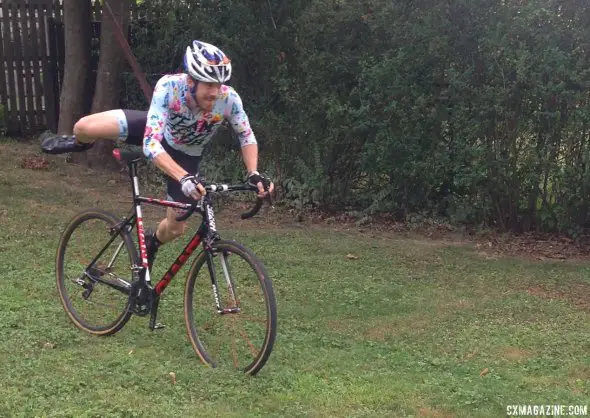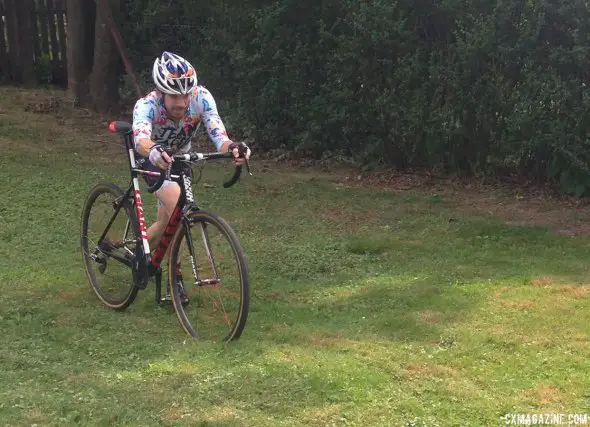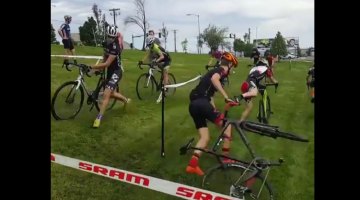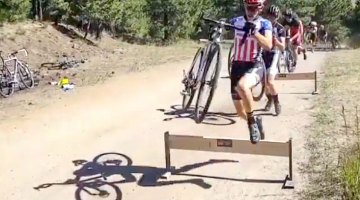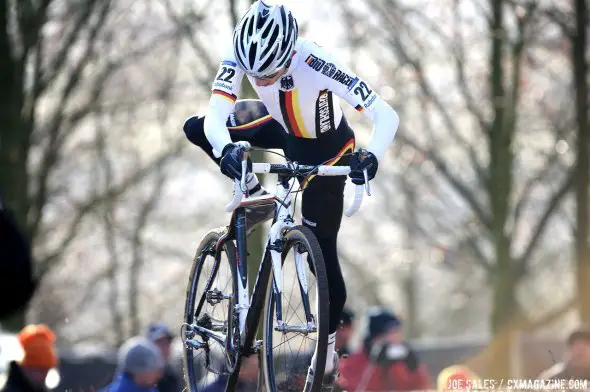
Phillip Walsleben (GDR) shows how to remount without jumping, but you need a flexible, strong groin and hip flexors (2009 Worlds). © Joe Sales
We’ve all gone through the stage of stutter-stepping when we are still sophomores of cyclocross, and back by popular demand, today we will be resurfacing a few solutions to eliminating the stutter-step. It is our strong suggestion that you read over the Technique Tuesday in order to avoid any rough groin injuries.
Let’s start with the reasons we stutter-step in the first place. Fear of landing wrong is one cause, and skipping your left foot against the ground is something of an insurance policy against hitting the saddle too hard. Another common reason for the stutter-step is that the technique used for remounts put the rider off-balance, and the stutter-step corrects the body from twisting too far in one direction.
Interestingly enough, we’ve observed that sometimes beginner and slower racers are less prone to stutter-stepping than strong category four and mid-pack category three racers. The former are far more interested in safely landing on their saddle while the latter mainly have speed on their brain. While we are not suggesting that you need to downgrade to get faster, there are a few things riders can learn from a slower approach to make their remount much smoother. Smoother eventually becomes faster. So let’s get started, and don’t be in a rush.
Avoiding Bad Habits, Figure Skaters and Superman
One way to remember how to remount is to act a little less like a figure skater and a little more like a kickboxer. What do we mean by this? Let’s start with the wrong approach first, something you can see many mid-level riders doing once they have gained plenty of confidence on the race course. Below is a picture of the figure skater technique.
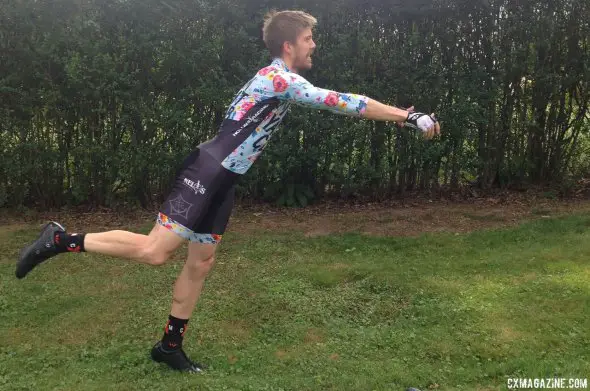
My weight is very far forward, and to hold this position, I often have to hop forward. It’s no wonder riders have to stutter-step from this position at high speeds. © Cyclocross Magazine
When I leap onto my bike from this precarious position, my body is sprawled out. You might be able to see why this is also called the “Superman Remount.”
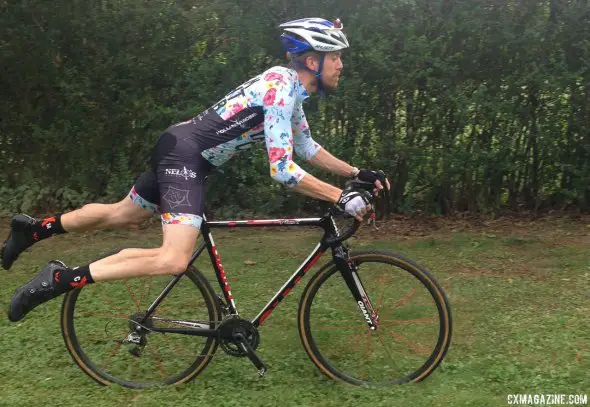
This is the Superman Mount halfway through, just as I’m pulling my body forward. While it’s fast, it increases the chances of stutter stepping, among other painful things. © Cyclocross Magazine
Some elite-level racers are able to pull this form off gracefully at high speeds. As for the rest of us, not only is our body weight unevenly balanced, causing us to stutter forward, but jumping on the bike with both feet back can also make it all the more difficult to find your pedals.
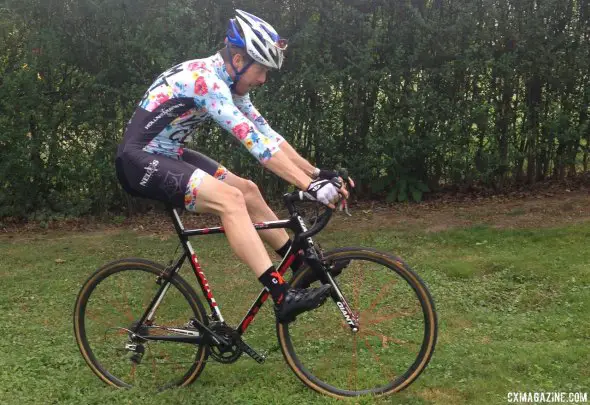
Leaping at high speeds with lots of momentum can have serious effects. Don’t laugh, this isn’t as rare as it should be. © Cyclocross Magazine.
The Efficient Way to Remove Stutter-Steps (the Kickboxer Position)
A small part of the problem that lends to stutter-stepping is committing to the jump, but the larger issue at play is both the technique you’re using and your demand for speed at any cost. Eric Oishi, a UCI racer and instructor at cyclocross clinics in New Jersey, has a mantra common to many elite-level riders: “Slow is smooth; smooth is fast.” He explains that you need to act like a kickboxer, with your left leg firmly planted on the ground, while your right leg rises like a sweeping kick. Look below at my correct stance, where my balance is situated much better.
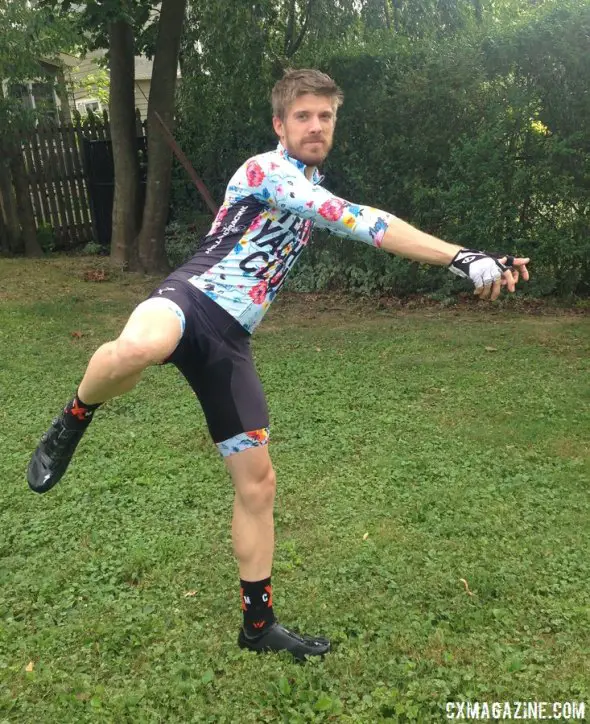
The Kick Boxing Position is far more stable. I could remain in this position far longer than the other way. © Cyclocross Magazine
When you’re learning to mount your bike from this position, it is much better to begin from a walk and work your way up to a run (slow is smooth, smooth is fast). For many relying on the Superman mount, their right leg is doing most of the work while their left leg is just along for the ride. Because of this, their torso slightly rotates to the left, and their left leg stutter is the way they naturally correct themselves from becoming completely off-balance. Oishi explains that in the kickboxing method, the left leg is doing most of the push off work, while the right leg is sweeping over the saddle.
One benefit of the kickboxing method is that it forces you to commit to the saddle. Secondly, if you’re primarily leaping from your left leg, you will realize that the need to stutter drastically diminishes. Stutter-stepping from the kickboxing pose means you have to intentionally leap hard twice, which is far easier to correct than attempting to fix the subconscious skipping around in the Superman leap. Still stutter-stepping? Re-examine the picture of Phillip Walsleben at the top of the article. You can’t technically stutter-step when your left foot never leaves the ground.
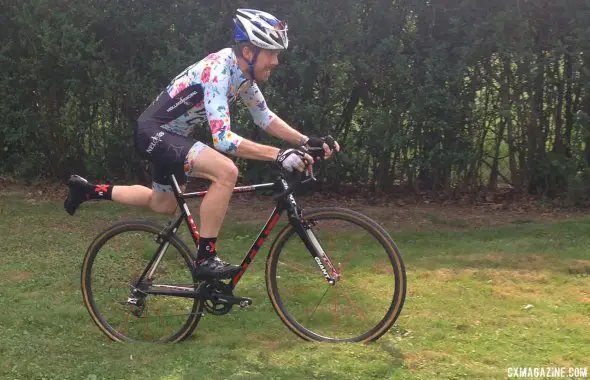
The right foot is immediately hunting for the pedal when the left foot has just pushed off from the ground. © Cyclocross Magazine
The Superman leap might be better in raw speed, but the kickboxing method is more efficient for most scenarios. Take a look back at the picture above. By the time both feet are in the air, the right foot is already hunting for the pedal, ready to clip in and allow me to accelerate. Here’s an older video of Nick Keough showing us how he approaches remounts:
A while back Tim Johnson weighed in on his advice to a reader struggling with the stutter step, revealing his secret, “Just as you’re about to leap towards or on the bike, push forward, then pull back the bike as a kind of jump start.”
Continuing Education Remount Training
Already smoothed out the stutter-step, and are looking for ways to quicken up the remount on the saddle? Or have you just learned to eliminate stutter-stepping, and are looking to test your instincts? A common habit of all racers is to remount in the least amount of steps after a barrier. While this might work fine if you’re riding solo, or surrounded by similarly-skilled racers, the reality is that you will likely be bunched together with other people in the first few sets of barriers, and someone may not be as fast as you in remounting. So, instead of hopping right bike on your bike, consider running with it instead during crowded, early laps. You’ll be surprised at how many places you can pick up.
This following drill not only checks to make sure you’re no longer stutter-stepping, but also gets your legs familiar with running at match-burning speeds. Hold your handlebars with your arms slightly bent, as shown below, and keep your left foot forward. From a stopped position, accelerate forward with an intentional count ahead of time; practice with two steps, four steps, and eight steps of sprinting before remounting. You’ll be carrying different speeds by the time you need to remount, which breaks up the monotony of the casual practice.
Oishi practices this drill without clipping in, which is great for two reasons: for beginners, it forces you to concentrate on proper remounting without a stutter-step. For the more advanced riders, the length of the coasting after remounting offers a good guide to the amount of speed you’re able to carry on foot.













